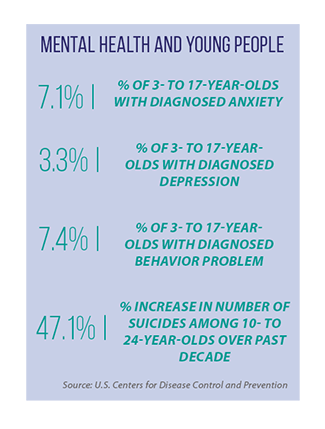State policies help spur rise in school-based mental health
In one Cleveland suburban district, licensed psychologists are regularly visiting schools and delivering clinical levels of care to students.
Hundreds of miles away, in the southernmost part of the state, a  small district is converting part of its board offices (located on the same campus as its schools) into a school-based health center. There, young people will get access to an array of services, including mental health treatment.
small district is converting part of its board offices (located on the same campus as its schools) into a school-based health center. There, young people will get access to an array of services, including mental health treatment.
These are two of the more than 3,000 local initiatives across Ohio getting state support because of legislative action taken two years ago — an unprecedented, $675 million funding commitment by the state to help schools provide nonacademic, wraparound services to students.
“As much as we like to say the education system is about academics, the reality is that those issues of student wellness are tremendously important to enabling a successful academic experience,” Ohio Superintendent of Public Instruction Paolo DeMaria says. “If children come to school hungry, or can’t see the whiteboard, or have a high level of trauma or stress, they’re not going to be in a position to be educated.”
Mental health, above all other types of eligible services, is what schools targeted for support through Ohio’s new Student Wellness and Success Fund. That choice is not surprising, DeMaria says, considering what he has heard from school administrators, teachers and parents on listening tours across the state.
And that was before the potential impacts of the COVID-19 pandemic on the mental health of people of all ages.
Across the country, “there was a ton of activity, pre-COVID, around state actions to support mental health and schools,” says Alex Mays, senior national program director for the Healthy Schools Campaign. If anything, circumstances of the past year will only heighten this activity.
“For a variety of reasons, the education sector is increasingly seeing its role as supporting the mental health of students and staff,” says Dr. Sharon Hoover, co-director of the National Center for School Mental Health. “At the same time, we see the behavioral health sector recognizing schools as an important venue for service provision. We also have more and more examples of how to structure those services and get reimbursed for them in the school setting.”
Policy options for states
Hoover points to a number of state-level, school-centered policies and investments that can help young people. One strategy is to improve mental health literacy among students.
“Just like we’d want young people to know about their physical health and nutrition as part of health education, we want them to understand mental health — how do you obtain and maintain positive mental health,” Hoover says.
Some states (New York and Virginia) have begun requiring mental health education as a part of the school curriculum, and Illinois was the first U.S. state to adopt standards for social emotional learning. Another option for states is to set a goal or requirement for the number of school-employed psychologists, social workers, counselors and nurses per student. (The ratio in nearly all states is currently below recommended levels.)
“Those staff are critical to providing universal mental health prevention and supports in the schools, and that can reduce the needs for higher levels of care,” Hoover says. “It’s not just looking immediately at what community providers we can bring in to the school.”
Increase in school-provider partnerships
That kind of outside help, though, can be essential, especially in delivering specialized, higher-level care to students. Many of the new state-funded initiatives in Ohio, for example, involve partnerships between the schools and local providers. Minnesota has one of the Midwest’s longest-running, comprehensive programs. Its grants for school-linked mental health services date back to 2007; they bring practitioners into the school building for direct care and treatment, assessments of student needs, and training of staff.
Separately, Minnesota has a “safe school levy,” a provision in state law that permits local districts to collect property taxes for specific purposes, including the hiring of licensed school counselors, nurses, psychologists and social workers, as well as contracting with mental health professionals.
Sen. Greg Clausen, a leading legislative advocate of school-based mental health, traces his interest in the issue back to his past experience as a school principal and administrator.
“There were a number of students where you saw the need, and there was a frustration that we didn’t have a lot of services we could provide,” Clausen says. “And then when we tried to go outside the school, it was, ‘Well, we can get you in in three months.’
“It really provided the spark that we needed to do something.”
According to Mays, who tracks state activity across the country for the Healthy Schools Campaign, Michigan has emerged as a leader in recent years on school-based mental health — for example, appropriating $31 million for schools to bring in licensed behavioral health providers and changing the state’s Medicaid program so that it can cover services for general-education students (those who don’t have an individualized education plan).
“The challenge you run into a lot is whether a state program is sustainable or whether it’s just a one-off,” Mays says. “That why I think it’s important for states to look at ways to tap into health care funding, like Medicaid. “If these services were being provided in a hospital or a community clinic, it would be reimbursed, no questions asked. Schools should be recognized as another site of service.”
That change in Medicaid policy, she adds, is needed specifically for services being provided by school-employed staff. (Outside mental health providers already can be reimbursed.)
According to Hoover, a variety of funding streams are now available to provide for school-based mental health, including new federal grants, greater flexibility in public and private insurance plans, and programs being developed by the states themselves.
Ohio’s $675 million Student Wellness and Success Fund is a case in point.
“Maybe 10 years ago, you would have heard the argument, ‘This is not what schools ought to be about,’ ” DeMaria says. “Not anymore.”
Examples of state actions in Midwest to bolster school-centered mental health policies

To improve early detection of student needs, school-entry health exams in Illinois must include screenings for social and emotional well being (SB 565 of 2017). Illinois also was the first U.S. state to adopt standards for social emotional learning.
 Under a 2019 law (SB 325), Indiana has begun offering grants for schools to develop plans that help students in need of mental health services. These plans (developed with parental involvement and consent) can include school-based or outside services. Iowa’s top school official is helping lead that state’s first-of-its-kind, stand-alone Children’s Mental Health System.
Under a 2019 law (SB 325), Indiana has begun offering grants for schools to develop plans that help students in need of mental health services. These plans (developed with parental involvement and consent) can include school-based or outside services. Iowa’s top school official is helping lead that state’s first-of-its-kind, stand-alone Children’s Mental Health System.
 Iowa’s top school official is helping lead that state’s first-of-its-kind, stand-alone Children’s Behavioral Health System. Created two years ago (HF 690) to close gaps in access and improve services, this system is overseen by a state board, with the Department of Education director serving as one of two
Iowa’s top school official is helping lead that state’s first-of-its-kind, stand-alone Children’s Behavioral Health System. Created two years ago (HF 690) to close gaps in access and improve services, this system is overseen by a state board, with the Department of Education director serving as one of two
standing co-chairs.
 Legislative appropriations in Kansas in recent years have led to the creation of mental health intervention teams in select school districts. School liaisons and clinical therapists in the community work on these teams; they help identify students in need and connect them to appropriate services.
Legislative appropriations in Kansas in recent years have led to the creation of mental health intervention teams in select school districts. School liaisons and clinical therapists in the community work on these teams; they help identify students in need and connect them to appropriate services.
 According to Alex Mays of the Healthy Schools Campaign, Michigan is a national leader on school-based mental health, noting it was one of the first U.S. states to have such services covered by Medicaid. This year, too, legislators dedicated nearly $37 million for mental health services
According to Alex Mays of the Healthy Schools Campaign, Michigan is a national leader on school-based mental health, noting it was one of the first U.S. states to have such services covered by Medicaid. This year, too, legislators dedicated nearly $37 million for mental health services
in schools.

More than a decade ago, Minnesota launched the groundbreaking School-Linked Mental Health Services program. Along with bringing clinical-level care to schools, the program helps identify children with serious mental health needs.
 A bill introduced this year in Nebraska (LB 87) would dedicate a portion of lottery proceeds to grants that train teachers and other school personnel in mental health first aid. The goal: Ensure students in crisis get immediate help, and get connected to appropriate services in the community.
A bill introduced this year in Nebraska (LB 87) would dedicate a portion of lottery proceeds to grants that train teachers and other school personnel in mental health first aid. The goal: Ensure students in crisis get immediate help, and get connected to appropriate services in the community.
 In recent years, North Dakota has started and expanded a prevention and early intervention program in the schools. The pilot initiative helps schools integrate behavioral health strategies into existing educational and support systems
In recent years, North Dakota has started and expanded a prevention and early intervention program in the schools. The pilot initiative helps schools integrate behavioral health strategies into existing educational and support systems
for students.
 Ohio is investing a historic amount of state dollars this biennium on student wellness. The $675 million Student Wellness and Success Fund goes to projects developed by local schools. That includes new school-based mental health services and partnerships with community providers.
Ohio is investing a historic amount of state dollars this biennium on student wellness. The $675 million Student Wellness and Success Fund goes to projects developed by local schools. That includes new school-based mental health services and partnerships with community providers.
 Across Saskatchewan, at least one staff member in every school will receive training this year on “mental health first aid” — for example, recognizing symptoms of students in crisis, providing initial assistance and connecting them with professional care. Saskatchewan is spending $400,000 on this training.
Across Saskatchewan, at least one staff member in every school will receive training this year on “mental health first aid” — for example, recognizing symptoms of students in crisis, providing initial assistance and connecting them with professional care. Saskatchewan is spending $400,000 on this training.
 In South Dakota, as part of the state’s Project AWARE initiative, system of care coordinators are forging new relationships between local school districts and the state’s community mental health centers. These coordinators help assess student needs and develop action plans.
In South Dakota, as part of the state’s Project AWARE initiative, system of care coordinators are forging new relationships between local school districts and the state’s community mental health centers. These coordinators help assess student needs and develop action plans.
 Students in Wisconsin are being empowered to recognize the warning signs of depression and suicide among their peers, and then offer evidence-based supports. State funding for peer-to-peer training is the result of last year’s passage of AB 528. Wisconsin high schools can now apply for state grants.
Students in Wisconsin are being empowered to recognize the warning signs of depression and suicide among their peers, and then offer evidence-based supports. State funding for peer-to-peer training is the result of last year’s passage of AB 528. Wisconsin high schools can now apply for state grants.